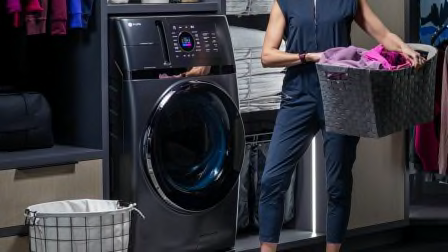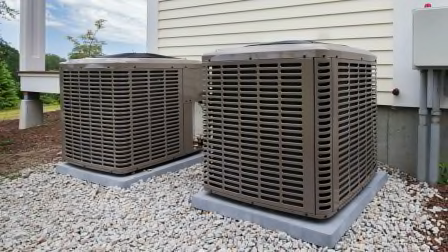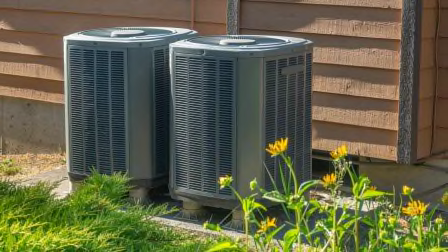Can Heat Pumps Actually Work in Cold Climates?
Yes, they can—if carefully chosen and properly installed. Here's what you need to know.
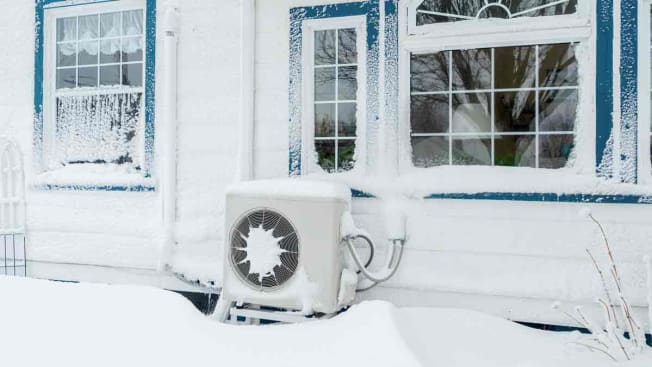
Heat pumps are emerging as an important tool for helping to thwart climate change—not just in the South, but all over the country. They’re more energy-efficient than traditional heating and cooling systems, and will almost always reduce your household carbon emissions—often substantially, especially when they run on cleaner sources of electricity.
While heat pumps have been common in the warmest parts of the U.S. for decades, the conventional wisdom was that air-source heat pumps—the most common type because they’re easy to install and cost less than ground-source heat pumps—don’t make sense in places where temperatures drop below freezing. That’s because heat pumps work by absorbing free heat from the air outside your home and then transferring it inside. This is more difficult when the temperatures are lower because they’ll struggle to keep your house comfortable even in a mild cold snap, the story goes, and they won’t run efficiently in that kind of weather anyway. If you want high-efficiency electric heating in a cold climate, experts say you’ll need an expensive, hard-to-install ground-source heat pump, which absorbs heat from underground.
CR explains how buying a heat pump for your home could get you thousands of dollars in federal tax credits and state rebates.
What to Look For in a Heat Pump for a Cold Climate
There’s no official “cold climate” standard for heat pumps. But the Energy Star standard for air-source heat pumps does include a certification mark for cold-climate heat pumps, signifying a suitable level of low-temperature performance and efficiency.
NEEP, Lis’ organization, maintains a database of heat pump models that will perform well in cold weather. Many models in the database can heat as effectively at a frigid 5° F as they can at a mild 47° F, and can also work pretty well at temps well below zero. In other words, these heat pumps are built for the big swings in temperatures that the Northeast and Midwest see every winter.
The key feature in a cold-climate heat pump is a variable-speed compressor, powered by an inverter. This kind of compressor can be helpful for heat pumps in any climate, but it’s especially beneficial in regions with big differences between the seasons. It enables a single heat pump to work efficiently and effectively in the deepest freeze of winter, the most oppressive summer afternoon, and all the milder days in between.
The other advantage is that a variable-speed system holds a steadier temperature (and in cooling mode, humidity level) than a traditional single-speed heating, ventilating, and air conditioning (HVAC) system. Those one-speed setups are more prone to letting your indoor climate swing around as they switch on and off throughout the day, says Iain Walker, PhD, a building scientist at the Lawrence Berkeley National Laboratory in California.
Lis compares it to the accelerator in a car: Single-speed heat pumps can go either 0 or 100 mph. Variable-speed systems can run at many speeds in between. On a bitter night in February or muggy day in July, it will cruise at highway speeds. On a milder day in October or April, it’ll crawl along like it’s in a school zone. It’ll rarely need to hit its top gear. Variable-speed models also help save energy, for the same reason that your gas mileage is better when you drive at a steady, moderate pace, rather than revving the engine and then slamming the brakes, over and over.
Another technology that has helped make low-temperature performance possible is flash (or vapor) injection. Standard heat pumps can lose their heating capacity (that is, how large a space they’re able to keep warm) as the outdoor temperature drops. So a heat pump that can keep your house comfy when it is 40° F outside might struggle below 25° F. But cold-climate heat pumps can open up a shortcut in their refrigerant loops in low temps, boosting the cold-weather heating performance. The efficiency drops a bit when it runs in this mode, as well as when it occasionally runs a self-defrosting cycle. (Ice can build up on the heat pump’s coils in cold weather, and it needs to be melted periodically.) But even when it draws extra energy use in this mode, it’s still considerably more efficient than an electric resistance or fuel-fired system, Lis says.
Like “regular” heat pumps, cold-climate heat pumps commonly come in two varieties: ducted or ductless. If your home already has good ductwork, you’ll most likely select a ducted heat pump. If your home doesn’t have ductwork—for instance, you currently heat with radiators, or you’re adding climate control to a garage, an attic, or a home addition—you’ll usually get a ductless system, often called a mini-split. (This is what Traxler, the YouTuber in Minneapolis, uses to heat his home.) Both types are equally capable of efficient, effective cold-weather performance, and the difference is simply about how they deliver heat (and cooling).
For more details about the different types of heat pumps and how they work, see our heat pump buying guide.
How Heat Pumps (Might) Help You Save Money, Even in a Cold Climate
Lis, at NEEP, told us that by his account, the first wave of cold-climate heat pump adoption in the Northeast was in northern New England, following a spike in the price of heating fuel in the early 2010s. For many residents there, it simply cost less to keep their homes warm with a heat pump than with propane or oil (the common fuels in that region, along with wood). And as a bonus, many of these homes suddenly had air conditioning for the first time.
But will a heat pump save you money, or at least break even compared with your other HVAC options? One study from UC Davis, conducted in 2021, estimates that 32 percent of households in the U.S. (including many in very cold regions) would save money by switching to a whole-home heat pump system, and if subsidies for heat pumps become more common, that savings could increase, especially if the price of fuel remains as high relative to electricity as it currently is. (Take a look at these Department of Energy fact sheets to get a sense of what the savings might be in your state.)
The biggest money savers are likely to be people who currently heat with “delivered” fuels like propane and oil (just like many of those early adopters in New England), as well as people who get their heat from electric furnaces or electric baseboard radiators.
Jerome Edgington, a machinist from Leicester, Mass., installed a mini-split system in his home at the end of 2019. In each of the coldest months, he reported saving an average of about $150 compared with what he would have paid by running his oil boiler. Because natural gas isn’t available in his area and a ground-source heat pump would have been very expensive and complicated to install, “air source heat pumps seemed like the only viable option,” he says.
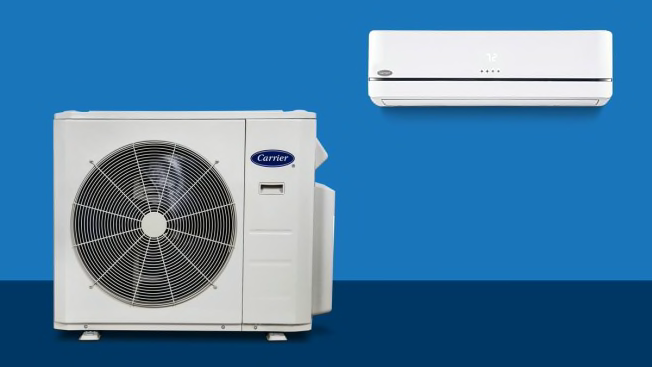
Photo: Carrier Photo: Carrier
However, heating with natural gas tends to cost less than using a heat pump. Lis says the operating costs are getting closer as heat pumps become more efficient. “It’s not a runaway,” he says. But on an individual level, it’ll depend on your regional climate, whether you’re having a harsh or mild winter, your home’s specific HVAC equipment, whether your equipment was installed well, and your local utility prices.
Dave Adams, a pastor and home renovator from Fort Wayne, Ind., installed a ducted heat pump with good cold-climate specs in 2020 to replace a broken air conditioner and an aging gas furnace. He claims in a YouTube video that his heating costs did increase by about $270 year over year, though a significant portion of that came during one unusually cold month. In cooling mode, the heat pump was so much more efficient than his old AC that he says his family almost broke even on their total heating and cooling costs in the first year of ownership, as he lays out in a series of YouTube videos.
So what about the cost of installation? Cold-climate heat pumps also tend to be more expensive to buy and install than other HVAC equipment—often even more than the combined cost of a decent furnace and central AC. But like everything in HVAC, there are plenty of exceptions.
After receiving a quote of $4,700 to replace his broken central air conditioner with a minimum-efficiency, 2.5-ton unit, Adams told us that he ultimately paid significantly less than what he was quoted for a high-efficiency, 3-ton all-climate heat pump—one that a reasonably skilled DIYer could install without the help of an HVAC professional. He wasn’t necessarily looking to buy a heat pump at all because his gas furnace still worked, but “it was just the best deal,” he says. It has worked as advertised, and kept his home warm even when temperatures dropped to minus 9° F. Traxler, from Minneapolis, says he paid about $2,300 in 2016 for the purchase and installation of two independent mini-split systems (one for each level of his home), though he also performed most of the installation on his own.
At the other end of the spectrum, some homeowners in the Northeast have paid more than $30,000 for a professionally installed ducted cold-climate air-source heat pump to serve as their sole heating source, according to data shared with CR, collected by the Cadmus Group for a study on cold-climate heat pump costs and performance. According to the data for 22 homes, the average cost per square foot for a heat pump (including installation) is about $10.36, though the range of prices is wide—from $3.52 to $16.98, with no clear pattern around ductwork requirements. We recommend that given the wide array in HVAC pricing, seek out multiple quotes to make sure you’re getting the best possible deal.
Drafty homes can also be tough for heat pumps, according to Walker, the building scientist—and that means higher costs for installation as well as operation. Leaky, uninsulated walls and ducts are a problem for any heating system. “It’s been a headache for the HVAC industry forever, and still is,” Walker says. “It’s even true for regular furnaces.” But you’ll notice it more with a heat pump, because they blow cooler air than a furnace does. You don’t get the blast of heat from the vents to distract you from the chill everywhere else, and in very cold temperatures, your house might lose heat faster than the heat pump can keep up with.
So if you have a drafty home but want a heat pump, you’ll need to find a way to compensate if you want to stay comfortable. One way to do it is to buy a higher-capacity heat pump, but that’s expensive. The best option is to upgrade the insulation and air sealing around your home. That’s not free, either, but the upgrades tend to pay for themselves quickly, and some states offer subsidies for insulation and other weather-sealing measures.
To further sweeten the pot for heat pumps, several states now offer generous tax incentives or rebates for installing them, better tilting the math in their favor. You can find a list of subsidies available in your area at the Database of State Incentives for Renewables & Efficiency.
And, of course, you’ll also save money if you opt for a heat pump that isn’t constantly breaking down. To that end, CR has put together predicted reliability and owner satisfaction ratings for 29 of the top brands of ducted heat pumps, based on data about 10,158 heat pumps purchased by CR members between 2007 and 2023.
When You Might Need a Backup (or Hybrid) System
Even in milder parts of the U.S., where temperatures only occasionally drop below freezing, basic, single-speed heat pumps are often paired with a backup heating system to comfortably get their owners through cold snaps.
Today, you can certainly keep a backup for peace of mind. But if you install a modern heat pump that’s appropriate for your climate, as well as the size and condition of your home, you might not need a backup system.
Still, a system that combines a heat pump with another type of heating equipment could be the most cost-effective and comfortable setup. And it’ll still save energy compared with a traditional heating system too. You could call it a backup system, or you could think of it like a hybrid or dual-fuel system, but it’s the same principle. “You’re still making a big difference in terms of the gas you’re burning,” Walker says.
As for how much money you can save with a hybrid setup, there’s some debate. Whether a hybrid system makes sense for your home depends on the size of your home and its layout and draftiness, and whether you’re trying to maximize cost savings or your overall comfort. To explore more options, read about a few common hybrid setups in our heat pump buying guide.
















